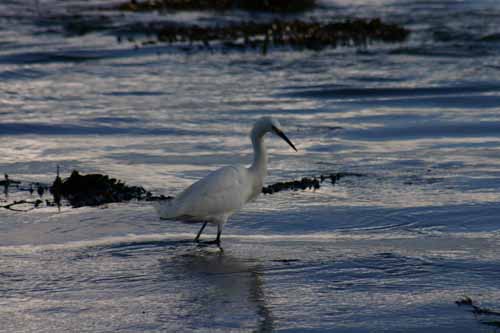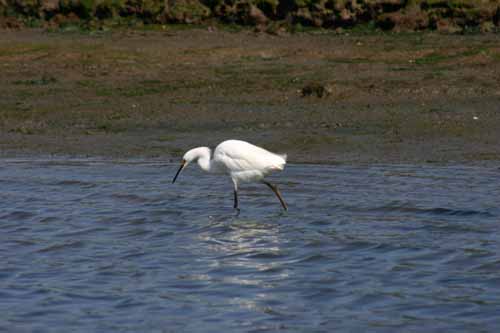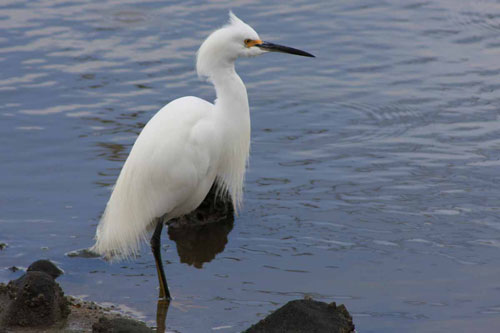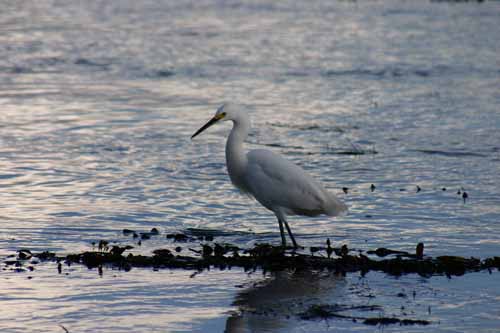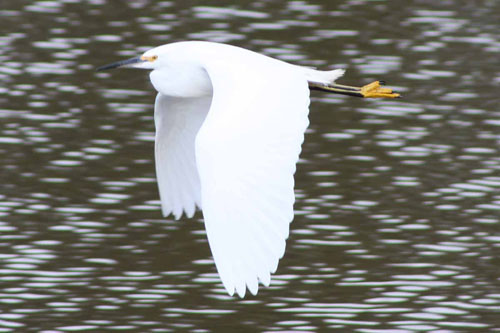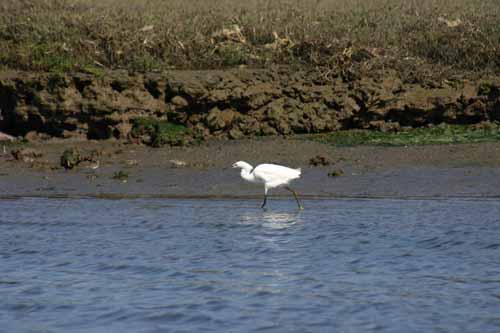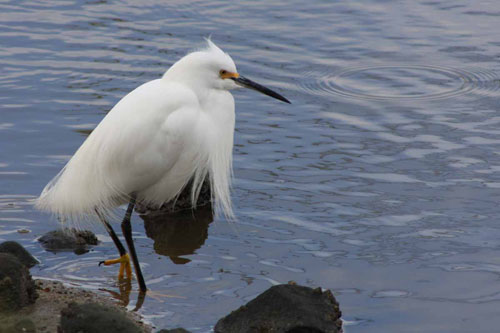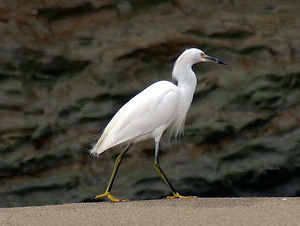
Snowy Egret
Egretta thula
Overview
Key Features:
All white feathers, black legs, and bright yellow feet.Similar Species:
Great Blue Heron (Ardea herodias)Great Egret (Ardea alba)
Primary Common Name:
Snowy EgretGeneral Grouping:
Seabirds and shorebirdsGeographic Range:
United States, Central and South America.
Egretta thula is found throughout North, Central, and South America as well as the Caribbean.Habitats:
bay (rocky shore), bay (sandy shore), estuary, kelp forest, protected rocky shoreNotes:
Egretta thula occupies a variety of shallow water habitats, including salt-marsh pools, tidal channels, shallow bays, mangroves, mudflats, freshwater swamps, lakes, large river mouths, grassy ponds, beaches, shallow reef areas, and wet grassy meadows. They prefer habitats among coastal areas and islands because of the availability of stable and abundant food sources.Abundance:
Relative Abundance:
Egretta thula is abundant.Species Description:
General:
Egretta thula is a member of the heron family. Small white heron. A small, active white heron, the Snowy Egret is found in small ponds as well as along the ocean shore. Its black legs and yellow feet quickly identify it. Class Aves, Order Ciconiiformes, Family Ardeidae, subfamily Ardeinae.Distinctive Features:
Egretta thula is a medium sized, slender, all white heron with yellow lores. It has a long, slender black bill, yellow eyes, and a long thin neck. The black legs are long and the feet are yellow. The breeding adult develops long, lacy, white plumes on the back, chest and crown, the lores turn red and the feet turn orange. Non-breeding plumage is similar, but the plumes are shorter and there is yellow on the back of the legs. The immature Egretta thula lacks plumes, shows some bluish-gray at the base of its lower mandible and has yellow legs with a black front edge.The Little Blue Heron, Egretta caerulea, also has completely white plumage, but can be distinguished from Egretta thula by their gray lores. The Little Egret, Egretta garzetta, is larger and stockier than Egretta thula and also has longer legs, bill and neck. The immature Little Blue Heron, Egretta caerulea, differs from Egretta thula with its pale, dull green legs and feet and the bill is mostly grayish with a black tip.
Size:
Egretta thula grows to a length of 61 cm with a wingspan of 100 cm and a weight of 370 g. Males tend to be slightly larger than the females.Natural History:
General:
Egretta thula walks upright with its wings held close to its body. This posture is ideal for foraging, because it allows Egretta thula to make quick directional changes to better catch its prey. They are most active at dawn and dusk and they can fly, but do not swim. They spend most of their day resting and engage in various self-maintenance behaviors, including grooming their wings, head-scratching to remove insects, and bathing. Egretta thula is a highly social bird that engages in group foraging, as well as interaction in nesting territories, with other bird species. They communicate through sound vocalizations and posture. Young birds make soft, buzzing calls while mature birds produce high and low-pitched calls. High-pitched calls are used at forage sites, while low-pitched calls, combined with upright posture and fully erect feathers, are used in aggressive situations. Greeting calls are common and males tend to use high sound vocalizations to attract a female mate. Egretta thula can live to an age of 22 years, though the expected lifespan is only 2 to 17 years.At one time, Egretta thula was hunted for their beautiful plumes which were used as decorations for women\\\\\\\\\\\\\\\\\\\\\\\\\\\\\\\'s hats. This reduced the population to dangerously low levels. Now that this egret is protected by law, its population has rebounded.
Egretta thula has shown an increased preference for island nest sites in urbanized, coastal estuaries. They choose urbanized locations over isolated locations, because isolated locations have more predators. They can use flight to escape predation from terrestrial animals and are known to have innate recognition and avoidance of poisonous snakes.
Predator(s):
Known predators on Egretta thula include Procyon lotor, racoon, Bubo virginianus, great-horned owl, Strix varia, barred owl, Corvus brachyrhynchos, American crow, Corvus ossifragus, fish crow, Alligator mississippiensis, American alligator, Elaphe obsoleta, rat snake, and Buteogallus anthracinus, common black-hawk.Prey:
Egretta thula's broad diet consists of earthworms, annelid worms, aquatic and terrestrial insects, crabs, shrimp, crayfish, snails, freshwater and marine fish, frogs, toads, lizards and snakes.Feeding Behavior:
CarnivoreNotes:
Egretta thula has the widest range of foraging behaviors when compared to other herons. They usually stalk prey in shallow water and their behavior may range from walking slowly and hovering, to running and shuffling their feet flushing prey into view. They commonly also sit still and wait to ambush prey. They primarily feed during the early morning and evening hours. They may forage in large groups, which allows for greater success in finding substantial food sources and provides some protection from predators. Egretta thula typically flies alone, though occasionally in groups, about 3 km from their colonies to their foraging sites.Seasonal Behavior
September - March
Migration:
Egretta thula is a year round resident in warmer, southern environments. However, northern populations tend to migrate south to their wintering areas in September, returning north again in early March.March - May
Reproduction:
Egretta thula breeds in coastal and inland wetlands, though its range limits have changed due to the effects of hunting and habitat loss. They nest in colonies, often with other egrets and herons. Nests are built on the ground or as high as 10 m in the trees. Breeding begins in late March or early April when the male Egretta thula performs flight displays and sound vocalizations to attract female mates. The most common courtship display one in which the male pumps his body up and down with his bill pointed towards the sky. The male then produces a call to attract females. Once paired off, the female builds the nest, while the male defends the territory. Their flat, shallow nests are composed of woven twigs and small sticks and may be lined with fine twigs and rushes. They may also reuse old nests. Females lay three to six greenish-blue eggs on average and both parents incubate the eggs. Incubation lasts 20 – 25 days and the chicks usually fledge 14 days after hatching. Young reach reproductive maturity after one to two years.References
- Alden, P., F. Heath, R. Keen, A. Leventer, and W. Zomlefer. 2002. National Audubon Society Field Guide to California. A.A. Knopf, New York, NY.
- Dunn, J.L. 1999. Birds of North America. National Geographic, Washington, D.C. 464 p.
- Weslosky, A. 2002. Egretta thula, Animal Diversity Web. World Wide electronic publication. http://animaldiversity.ummz.umich.edu, Accessed [06/11/06].
- WWW
Cornell Lab of Ornithology
All About Birds
http://www.allaboutbirds.org/guide/search
Accessed 05/17/2009 for Albatross
Accessed 01/15/2009 for Clark's Grebe
Accessed 01/20/2009 for Great Egret
Accessed 02/03/2009 for American White Pelican
Accessed 01/30/2009 for Pelagic Cormorant
Accessed 02/12/2009 for Black-necked Stilt
Accessed 02/28/2009 for Marbled Godwit
Accessed 03/15/2009 for Whimbrel
Accessed 04/11/2009 for Long-billed Curlew
Accessed 04/13/2009 for Heermann's Gull
Accessed 09/10/2009 for Eared Grebe
Accessed 11/11/2009 for American Avocet
Accessed 01/26/2010 for Pigeon Guillemot
Accessed 12/15/2009 for Black-crowned Night Heron
Accessed 07/07/2009 for Pied-billed Grebe
Accessed 04/04/2010 for Osprey
Accessed 08/30/2010 for Ruddy Turnstone
Accessed 10/10/2010 for Pacific Loon
Accessed 10/15/2010 for Sooty Shearwater
Accessed 10/30/2010 for Surf Scoter
Accessed 12/04/2010 for Bufflehead
Accessed 02/01/2011 for American Coot
Accessed 02/20/2011 for Western Sandpiper
Accessed 03/04/2011 for Least Sandpiper.
Accessed for California Condor
Related Information
Photo Library
Click on an image below to view a larger version in the SIMoN Photo Library. You will also be able to view important information on each photo such as photographer, date, caption and more
